VERY IMPERVIOUS AND HARD TO GET, OR WHAT THE HELL..?
I’m debating whether or not to tell you to go to Hell. Should you choose to go, playwright Steve Yockey will take you there in the world premiere of Very Still and Hard to See, a cluster of sporadically startling but ultimately opaque short stories that examine man’s dark side. Even with some wonderful dialogue, the playwright’s self-indulgent construction eschews an overarching story, which renders it impenetrable and not worth recommending, but if you want to witness the wickedly inventive Story Theatre-like staging of Michael Matthews, consistently the best director in Los Angeles, then by all means go to Hell.
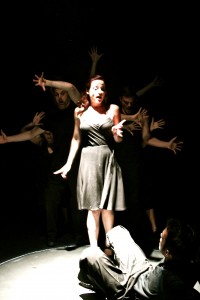 Buck, an architect with a dark secret, finds himself at the bottom of an incorporeal hole, where a female supernatural being named Obake strikes a bargain with him: either construct his new luxury hotel over this portal to the underworld, or die. Naturally, he balks. Surrounded by her writhing dogs of Hell, Obake does her best Darth Vader, choking the man with her dark force until Buck agrees. Before he returns to, um, earth, she lets him know that she’s going to get him in the end anyway.
Buck, an architect with a dark secret, finds himself at the bottom of an incorporeal hole, where a female supernatural being named Obake strikes a bargain with him: either construct his new luxury hotel over this portal to the underworld, or die. Naturally, he balks. Surrounded by her writhing dogs of Hell, Obake does her best Darth Vader, choking the man with her dark force until Buck agrees. Before he returns to, um, earth, she lets him know that she’s going to get him in the end anyway.
And so begins the series of mostly unrelated and muddled short stories, except that they all stem from or take place in this haunted hotel. Yockey, inspired by modern ghost stories, explores the themes of the Japanese folk tales “Of a Mirror & a Bell” and “Yuki-onna,” but that’s of little consequence to an audience who will be mystified as to what this event adds up to. Were it not for the program, we would never even know that the preternatural gatekeeper of Hell is named Obake (a shape-shifter in Japanese folklore); in fact, her home is never even referred to as Hell.
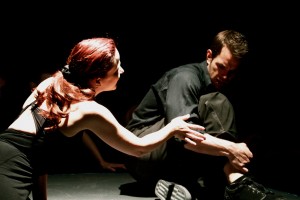 That’s fine; we don’t need a playwright to spell everything out for us, but Yockey seems content to let his conceit trump a predominant story. Also, the lack of a tangible association between these characters means that the short one-act (75 minutes) is only as good as the particular story at hand, some of which are better than others. While some of Yockey’s dialogue is fantastically arresting and irreverently funny, his is exactly the type of show one would come to expect from a Fringe entry, wherein playwrights who showcase their knowledge and fascination with theatrical genres, such as the Greek chorus, willingly create an event which becomes style over substance.
That’s fine; we don’t need a playwright to spell everything out for us, but Yockey seems content to let his conceit trump a predominant story. Also, the lack of a tangible association between these characters means that the short one-act (75 minutes) is only as good as the particular story at hand, some of which are better than others. While some of Yockey’s dialogue is fantastically arresting and irreverently funny, his is exactly the type of show one would come to expect from a Fringe entry, wherein playwrights who showcase their knowledge and fascination with theatrical genres, such as the Greek chorus, willingly create an event which becomes style over substance.
Two previous outings by Yockey also exhibited sketchy storytelling: Marin Theatre Company’s Bellwether (which also made use of an underworld) was somewhat illogical, but it was salvaged by humorous, insightful dialogue, and magnificent production values, but Boston Court’s beautifully produced Heavier Than’¦ (which also utilized a Greek chorus) was ultimately elusive.
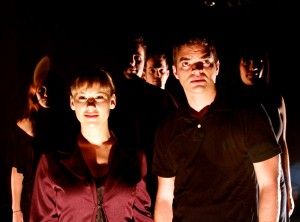 The biggest problem with Yockey’s stories is that they are in service to his device of incorporating Japanese occult folklore via Obake and her underworld minions, even as there is nothing remotely Asian about the production. Since actors serve double-duty as ghoulies and as more than one character in the stories, figuring out who is who, what is what, and how they are related becomes futile.
The biggest problem with Yockey’s stories is that they are in service to his device of incorporating Japanese occult folklore via Obake and her underworld minions, even as there is nothing remotely Asian about the production. Since actors serve double-duty as ghoulies and as more than one character in the stories, figuring out who is who, what is what, and how they are related becomes futile.
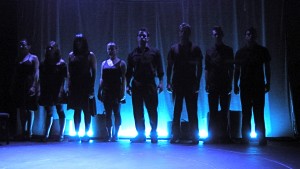 In one story, a Northeastern couple sits on the sidelines with giant books in their laps, advising some kind of lesbian murderess who has cannibalized 476 blind dates (did I get that number right, and does that figure mean anything?) But who are these indefinable creature-counselors that either possess characters in one scene or counsel them in another? I believe the couple are Shikigami 1 and 2 (again, I had to consult the program, which also confusingly listed Kami 1 and 2). Scenes such as this are slow to take off and they’re not disturbing. It was at this point in the play that the audience began squirming for all the wrong reasons.
In one story, a Northeastern couple sits on the sidelines with giant books in their laps, advising some kind of lesbian murderess who has cannibalized 476 blind dates (did I get that number right, and does that figure mean anything?) But who are these indefinable creature-counselors that either possess characters in one scene or counsel them in another? I believe the couple are Shikigami 1 and 2 (again, I had to consult the program, which also confusingly listed Kami 1 and 2). Scenes such as this are slow to take off and they’re not disturbing. It was at this point in the play that the audience began squirming for all the wrong reasons.
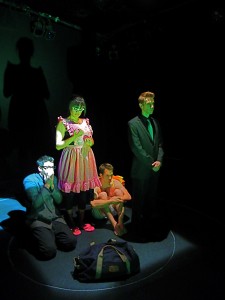 Consistently fascinating, however, was Michael Matthews’ staging. Utilizing techniques reminiscent of black-box theater of the 1970’s, Matthews’ actors crawl, twist, slither, hiss and cackle, creating such vivid scenarios that there was no need for a set or costume designer. The vocal work was also impressive, from disembodied voices to mysterious childlike lullabies (of the “My name is Talky Tina, and I don’t like you” variety). Still, even as Matthews showcases his astute intelligence for theatrical creation, Very Still rarely felt creepy and unsettling (actors shouting and slamming didn’t help). Some of the eerier elements came from the resourceful minds of sound designer Cricket S. Myers and lighting designer Tim Swiss.
Consistently fascinating, however, was Michael Matthews’ staging. Utilizing techniques reminiscent of black-box theater of the 1970’s, Matthews’ actors crawl, twist, slither, hiss and cackle, creating such vivid scenarios that there was no need for a set or costume designer. The vocal work was also impressive, from disembodied voices to mysterious childlike lullabies (of the “My name is Talky Tina, and I don’t like you” variety). Still, even as Matthews showcases his astute intelligence for theatrical creation, Very Still rarely felt creepy and unsettling (actors shouting and slamming didn’t help). Some of the eerier elements came from the resourceful minds of sound designer Cricket S. Myers and lighting designer Tim Swiss.
If Matthews’ staging was flawless, what explained the uneven acting? Since Yockey gives his characters little to no nuance, it is up to the actors to create character choices that make them distinctive. I wish that all of the actors had gone further to fill in the holes left by Yockey. It makes me wonder if the actors even knew what the play was about.
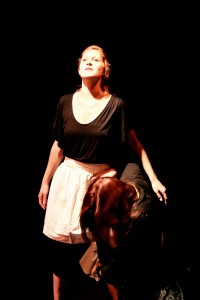 CB Spencer evoked a palpable sense of threat as Obake, but Andrew Crabtree struggled with presentational fear as the architect Buck. Katherine Skelton did some good work as an anxiously betrayed housewife who scrubbed a hole to Hell with some household cleansers, but when her hair fell in front of her eyes, she wiped it away with the fingertips of her rubber gloves, which would have been covered with bleach – why didn’t she use the back of her wrist? It is the lack of acting in the moment that keeps good actors from being great. James Louis Wagner played her cheating husband Ethan with all the right notes, but little sense of true terror.
CB Spencer evoked a palpable sense of threat as Obake, but Andrew Crabtree struggled with presentational fear as the architect Buck. Katherine Skelton did some good work as an anxiously betrayed housewife who scrubbed a hole to Hell with some household cleansers, but when her hair fell in front of her eyes, she wiped it away with the fingertips of her rubber gloves, which would have been covered with bleach – why didn’t she use the back of her wrist? It is the lack of acting in the moment that keeps good actors from being great. James Louis Wagner played her cheating husband Ethan with all the right notes, but little sense of true terror.
Other actors were Coleman Drew as a mortician-like elevator operator, Tiffany Cole as the architect’s granddaughter Simone, and Michael Tauzin as her boyfriend David – a fairly thankless role in a fairly thankless final scene that attempts to bring the play full-circle.
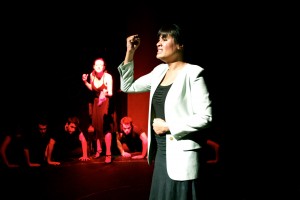 My favorite actress was Adeye Sahran as Edith, a woman who is vacationing with her husband at the hotel. Admittedly, her monologue about a vacation-gone-wrong was Yockey’s best writing of the night, but Sahran’s multi-leveled interpretation had her fighting back each emotion that dared rise to the surface. A truly glorious performance.
My favorite actress was Adeye Sahran as Edith, a woman who is vacationing with her husband at the hotel. Admittedly, her monologue about a vacation-gone-wrong was Yockey’s best writing of the night, but Sahran’s multi-leveled interpretation had her fighting back each emotion that dared rise to the surface. A truly glorious performance.
In the 1972 classic horror film Tales From the Crypt, five strangers become separated from a tour group in a crypt. To each in turn, the Crypt Keeper (Ralph Richardson) describes the manner in which they will die. The slim premise is wholly forgivable as each of the stories stands on their own merit as characters grapple with themes of evil and accountability. Very Still & Hard to See, subtitled “a short play cycle,” lacks a much-needed ambivalence about what constitutes evil. All I got from the play is that people do bad things because the devil made them do it (where’s Flip Wilson when you need him?) So, should you attend a show with an equivocal script but fabulous staging? It’s a helluva decision.
photos by Sean Lambert and Tim Swiss
Very Still & Hard to See
The Production Company @ The Lex Theatre in Hollywood (Los Angeles Theater)
scheduled to end on July 7
for tickets, call 800.838.3006 or visit http://theprodco.com
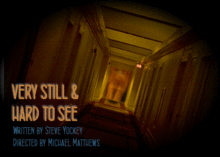

{ 1 comment… read it below or add one }
I don’t quite understand this review. I saw the play and found it genuinely scary–which is a difficult thing to accomplish in the theater. It sounds as though the reviewer would have preferred a play more closely tied to the stories that inspired it–that’s fine, but that’s not the playwright’s project, nor need it be. This stance reminds me of Tolstoy’s “On Shakespeare” essay: a 100 page screed in which he declares KING LEAR objectively awful for, among other things, how much it diverged from its source material.
Inspiration takes many forms, all valid. I didn’t know what the source of inspiration of the play was, and was easily able to take the experience for what it was, not what I think it should have been, or for how closely it resembled the play I would have written on the same subject. I didn’t need a solution to the mystery at its core: sometimes the monster is scarier when you never really get to see it head on. Terrors hinted at, or evoked in our imaginations, tend to be far more effective than those that are explained.
Everyone, go see this play with a group of people, then head to the bar around the corner and swap your own ghost stories. You’ll have a terrific night, I promise.